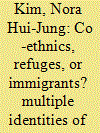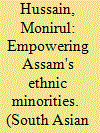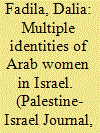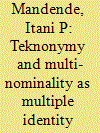|
|
|
Sort Order |
|
|
|
Items / Page
|
|
|
|
|
|
|
| Srl | Item |
| 1 |
ID:
147858


|
|
|
|
|
| Summary/Abstract |
The articles in this Special Issue critically examine a number of key aspects of North Koreans who have fled their home state and sought a new life in the ‘other’ Korea. The articles examine the landscape of government policy for North Koreans, the role of civil society and the media, and the lived experiences of North Koreans in South Korean society. The central theme of the Special Issue is the contentious politics of choosing and articulating identity categories; what kinds and by whom identity categories are imposed upon North Koreans and how North Koreans interpret these identity categories and strategically employ them. The Special Issue makes significant empirical and theoretical contributions to our understanding of North Koreans in South Korea and on the complex issue of ethnic boundary drawing.
|
|
|
|
|
|
|
|
|
|
|
|
|
|
|
|
| 2 |
ID:
113368


|
|
|
| 3 |
ID:
144678


|
|
|
|
|
| Summary/Abstract |
Israel and the Islamic Republic of Iran have had a problematic relationship for the last four decades. Despite their tense relations, Israel is home to thousands of Persians and Iran has the second largest Jewish population in the Middle East. There are social, political and psychological obstacles to dual identification. Using qualitative thematic analysis and Identity Process Theory, this article examines the construction and management of Persian/Iranian and Jewish/Israeli identities among these groups. The following themes are discussed: (1) the challenges and maintenance of dual identification, (2) breaking down boundaries between identities, and (3) Persian-Iranian or Jewish-Israeli? Establishing coherence in identity. Results suggest that, while the social and political institutions in Iran and Israel construct barriers to dual identification, individuals deploy creative strategies for constructing an ethnic identity that acknowledges both components of their heritage. The implications for self-identity are discussed.
|
|
|
|
|
|
|
|
|
|
|
|
|
|
|
|
| 4 |
ID:
130508


|
|
|
|
|
| Publication |
2011.
|
| Summary/Abstract |
I would like to open with the question: "history" or "her story?" This is the question that has been debated since the 20th century among different groups of women in developed societies. Those women have really moved along the continuum from "history" into "her story," though they are in different stages and are still moving. Yet, women in "developing societies" are not there yet. I would like to preface this with a note on the function of English grammar here. There is nothing developing in "developing" societies. The "ing" is a grammatical technique to perpetuate our static condition. Women in developing societies are still asking the question of whether to write the self, the subject that precedes writing history and which should be the narrative voice. They are still asking the question of why politics, ethnicity, religion, economy, and technology are hindering the writing of the self that ought to be writing history and any narrative of the self and society.
The complexity of holding multiple identities, of being a woman who is Arab, Muslim, a member of a minority and Israeli, must be emphasized. This complexity is a dynamic of clashing variables and it is also the status quo. The clashing variables can be described as follows: Arab contradicts Israeli, Israeli contradicts Muslim, Muslim contradicts women, women are being marginalized by Arabs, Arabs marginalize Israel, Israel marginalizes everybody else and the rest of the world marginalizes all of the above. These clashing variables are going nowhere as they love to clash, which is why they are the status quo. Where does this leave the multi-layered identity of women? In an arena of tension between her own two ambivalent attitudes.
|
|
|
|
|
|
|
|
|
|
|
|
|
|
|
|
| 5 |
ID:
155800


|
|
|
|
|
| Summary/Abstract |
This paper investigates teknonymy and multi-nominality as multiple identity markers for Vhavenḓa from an autochthonic view. Employing an ethnographic research design, and locating its argument within a six-pronged theoretical framework, the paper gleaned its data from two sources − interviews and document reviews. Its participants comprised 100 respondents. From this standpoint, the paper has mounted a discussion of the Vhavenḓa teknonymy. With reference to the latter, it has given pride of place to both teknonymy and multi-nominality, arguing that the two help engender multiple references, multiple addresses, and multiple identities
|
|
|
|
|
|
|
|
|
|
|
|
|
|
|
|
|
|
|
|
|